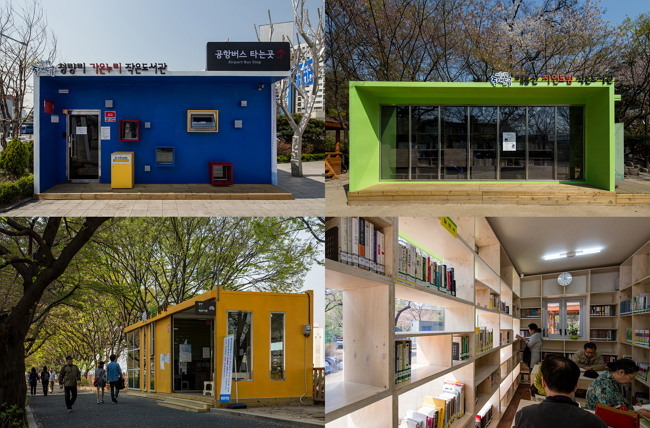[Weekender] Designs for life
Korea’s interest in public design moves beyond aesthetic improvement
By Lee Woo-youngPublished : Nov. 7, 2014 - 21:45
Nearly a decade after Seoul City’s urban beautification campaign, design has become an essential part of urban planning in Korea.
In Seoul, flashy new buildings continue to pop up, creating some noticeable spots in its repetitive sprawl of cookie-cutter structures. Some even resemble a tsunami (the new Seoul City Hall) or a spaceship (the Dongdaemun Design Plaza).
Although not as noticeable as the new edifices, traffic signs, bus stops and advertisements are being given a designer touch. Rooftops are being turned into gardens and murals are being painted on walls.
Type the Korean words for “public design” into a search engine, and you get a glimpse of what’s happening.
In a seemingly endless list of announcements, provinces and cities seek creative design ideas to improve the look of their towns and, in some cases, address crime and other problems with design.
“The concept of public design has been around in Korea for only about 15 years, but it has spread so quickly that now every government (at the provincial and municipal level) has someone in charge of public design,” said Yoon Seong-won, an official at the state-run Korea Institute of Design Promotion. “It’s a far cry from the not-so-distant past when people didn’t understand why they needed to spend money on making things look good.”
In Seoul, flashy new buildings continue to pop up, creating some noticeable spots in its repetitive sprawl of cookie-cutter structures. Some even resemble a tsunami (the new Seoul City Hall) or a spaceship (the Dongdaemun Design Plaza).
Although not as noticeable as the new edifices, traffic signs, bus stops and advertisements are being given a designer touch. Rooftops are being turned into gardens and murals are being painted on walls.
Type the Korean words for “public design” into a search engine, and you get a glimpse of what’s happening.
In a seemingly endless list of announcements, provinces and cities seek creative design ideas to improve the look of their towns and, in some cases, address crime and other problems with design.
“The concept of public design has been around in Korea for only about 15 years, but it has spread so quickly that now every government (at the provincial and municipal level) has someone in charge of public design,” said Yoon Seong-won, an official at the state-run Korea Institute of Design Promotion. “It’s a far cry from the not-so-distant past when people didn’t understand why they needed to spend money on making things look good.”

By definition, public design is an inclusive label, covering any design that is driven by public service, not profit, serves groups that are not clients or seeks solutions to problems that are relevant to the public.
This could mean works of art, architecture and landscape architecture proposed on publicly owned property, such as museums and libraries, parks and playgrounds, or the installation of lighting, traffic signs and other streetscape elements.
At the vanguard of the country’s public design buzz has been Seoul, the country’s capital with a population of over 10 million.
In the 2000s, the city’s two mayors ― Lee Myung-bak, who later became president, and Oh Se-hoon ― pushed for an urban beautification campaign, stressing the need for aesthetic improvement through public design.
Lee restored Cheonggyecheon Stream, then a slim watercourse covered by an asphalt motorway and an overpass. Oh commissioned designs of what he said would be landmark buildings from renowned international architects. The new City Hall and the DDP were his pet projects.
Their endeavors, which had the stated aim of turning Seoul into an attractive city for both locals and international travelers, were costly and had a top-down approach, which irked many taxpayers as well as designers. The legacies of the two mayors are still debated in Korea.
Kim Kyoung-kyun, a design professor at Korea National University of Arts, thinks design initiatives under the two mayors had a fundamental flaw. They believed a quick fix was possible to change a city’s look.
“Seoul tried to benchmark foreign cities (known for their unique design identities) and churned out some architectural works that do not seem to reflect the cultural or historical context of the existing surroundings,” he wrote in a column. “But a city’s design aesthetic can only be shaped over time by its inhabitants and must be understood in the context of its cultural and historical background.”
Reflecting the criticism, a new trend has emerged in discussions of urban redesign.
Instead of costly landmark projects, designers are working to improve crooked and narrow alleys.
A shantytown has become a tourist attraction after bright colors were painted on footpaths and walls to relieve people’s fear of crime. A rundown village perched on top of a steep hill got the nickname of Santorini, a Greek island known for its beautiful houses on a hill.
“In essence, design is about solving problems with creative ideas. Public design also should be like that ― solving a city’s problems with design,” Yoon said.
By Lee Sun-young (milaya@heraldcorp.com)








![[Graphic News] More Koreans say they plan long-distance trips this year](http://res.heraldm.com/phpwas/restmb_idxmake.php?idx=644&simg=/content/image/2024/04/17/20240417050828_0.gif&u=)
![[KH Explains] Hyundai's full hybrid edge to pay off amid slow transition to pure EVs](http://res.heraldm.com/phpwas/restmb_idxmake.php?idx=644&simg=/content/image/2024/04/18/20240418050645_0.jpg&u=20240419100350)





![[From the Scene] Monks, Buddhists hail return of remains of Buddhas](http://res.heraldm.com/phpwas/restmb_idxmake.php?idx=652&simg=/content/image/2024/04/19/20240419050617_0.jpg&u=20240419175937)

![[KH Explains] Hyundai's full hybrid edge to pay off amid slow transition to pure EVs](http://res.heraldm.com/phpwas/restmb_idxmake.php?idx=652&simg=/content/image/2024/04/18/20240418050645_0.jpg&u=20240419100350)

![[Today’s K-pop] Illit drops debut single remix](http://res.heraldm.com/phpwas/restmb_idxmake.php?idx=642&simg=/content/image/2024/04/19/20240419050612_0.jpg&u=)